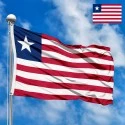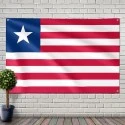The national flag of the Republic of Liberia is a potent symbol of the nation's unique history as a land founded by freed American slaves, often referred to as a "Little America" in Africa. Adopted on August 24, 1847, just weeks after Liberia declared its independence from the American Colonization Society, the flag's design deliberately echoes the Stars and Stripes of the United States, reflecting the origins of its founders and their aspirations for liberty and self-governance. It stands as a proud testament to the resilience, determination, and enduring ties to its foundational principles.
Design and Symbolism: Echoes of Liberty and American Heritage
The flag of Liberia is characterized by its prominent use of red, white, and blue, arranged in horizontal stripes and a single star on a blue canton. Each element of the design carries profound symbolism:
-
Eleven Horizontal Stripes (Six Red, Five White): The flag features eleven alternating horizontal stripes, six red and five white. These stripes represent the eleven signatories of the Liberian Declaration of Independence. This signifies the foundational individuals and their commitment to the establishment of the independent republic.
-
Red Stripes: The six red stripes symbolize valor and steadfastness. They represent the courage, determination, and sacrifices made by the pioneers and their descendants in establishing and defending the nation. Red also alludes to the blood shed in the pursuit of liberty.
-
White Stripes: The five white stripes symbolize purity, innocence, and integrity. They reflect the moral principles and high ideals upon which the Liberian nation was founded, emphasizing the pursuit of a just and righteous society.
-
Blue Canton (Upper Left Corner): The large blue square, known as the canton, is positioned in the upper left corner of the flag. This blue field represents the African continent upon which Liberia is situated. It signifies the vastness and richness of Africa, and Liberia's place within it as a beacon of liberty. More broadly, it symbolizes the liberty, fidelity, and justice that the nation strives to uphold.
-
White Five-Pointed Star (on Blue Canton): Centrally placed within the blue canton is a single, prominent white five-pointed star. This star is the most powerful and iconic symbol on the flag. It represents Liberia as the only independent republic in Africa at the time of its founding. It signifies the shining light of freedom emanating from Africa, serving as a beacon of hope and a guiding star for other African nations yet to achieve independence. The five points of the star often represent the principles of unity, liberty, justice, faith, and peace.
The overall design strikingly resembles the flag of the United States, a deliberate choice by the founders to acknowledge their origins and to symbolize their newly found liberty in a new land, mirroring the ideals of the American Revolution.
Dimensions and Proportions:
The official proportions of the Flag of Liberia are a width-to-length ratio of 10:19. This ratio is identical to that of the United States flag, further emphasizing the historical and symbolic connection between the two nations. The stripes are of equal width. The blue canton extends downwards to the bottom edge of the fifth red stripe (or the fifth white stripe, depending on how one counts, effectively encompassing five stripes from the top), and extends horizontally for the width of five stripes. The white star is centrally placed within this blue canton, with its size proportioned to be clearly visible without dominating the canton. This meticulous adherence to a similar structure as the US flag underscores the deep ties and shared values.
History and Evolution: A Flag Born of Freedom
The history of the Liberian flag is intrinsically linked to the narrative of American freed slaves seeking a new home and establishing an independent nation in Africa.
-
Founding of Liberia (1822): Liberia was established in 1822 by the American Colonization Society, an organization that believed Black people would face better chances for freedom and prosperity in Africa than in the United States. Many freed slaves and free-born African Americans emigrated to this new settlement on the West African coast.
-
Declaration of Independence (1847): Over the next few decades, the settlement grew, and its inhabitants, facing various challenges and seeking full autonomy, decided to declare independence. On July 26, 1847, Liberia formally declared itself an independent republic.
-
Adoption of the Flag (1847): With the declaration of independence, a new national symbol was needed. A committee of seven women was formed to design the flag. Mrs. Susannah Lewis, a prominent figure in the community, is credited with leading this committee and designing the flag. The flag was officially adopted and first unfurled on August 24, 1847, just shy of a month after the declaration of independence. Its design deliberately drew inspiration from the United States flag, but with key distinctions to represent Liberia's unique journey: the eleven stripes instead of thirteen (for the signatories of the Declaration), and a single star instead of multiple, symbolizing Liberia as the sole independent Black republic in Africa at the time.
-
Enduring Symbol: Since its adoption, the Liberian flag has remained remarkably consistent in its design, serving as a continuous symbol of the nation's sovereignty and its founding principles. Unlike many other African nations that saw flag changes post-independence from colonial powers, Liberia's flag has stood the test of time, reflecting its unique genesis.
The flag represents not only the independence of Liberia but also the aspirations for self-determination and dignity for people of African descent globally.
Regional Context and West African Identity:
Liberia is located on the West African coast, bordering Sierra Leone, Guinea, and Côte d'Ivoire. Its flag, with its strong resemblance to the U.S. flag, is unique in the regional context of African flags. While many African nations adopted Pan-African colors (red, yellow, green, black) or colors significant to their pre-colonial kingdoms upon gaining independence from European colonial powers, Liberia's flag stands apart due to its direct historical link to the United States.
This distinctive design highlights Liberia's exceptional history as a nation founded by repatriated people, rather than emerging from a traditional colonial liberation struggle against a European power on African soil. It represents a different kind of independence – one rooted in the quest for self-determination by former slaves and free African Americans. While Liberia shares cultural and some historical ties with its West African neighbors, its flag visually distinguishes it, underscoring its unique origins and its role as a pioneer of republicanism and self-governance in Africa. It is a symbol that resonates not just within Liberia but also among the African diaspora worldwide.
Interesting Facts:
-
"Lone Star Flag": The Liberian flag is often affectionately referred to as the "Lone Star Flag," emphasizing the single star that symbolizes Liberia's unique status as Africa's first independent republic.
-
Designed by Women: A committee of seven women, led by Mrs. Susannah Lewis, is credited with designing the flag, a notable fact in the history of national flags.
-
Modeled After the U.S. Flag: Its strong resemblance to the U.S. flag is intentional, reflecting the American origins of the country's founders. This sometimes leads to confusion or misidentification.
-
Shipping Convenience (Flag of Convenience): Due to Liberia's open registry laws and relatively low fees, its flag became (and remains) one of the most popular "flags of convenience" for merchant shipping worldwide. Many ships from various countries are registered under the Liberian flag to benefit from its maritime regulations, making the Liberian flag a common sight in ports globally, often more so than the flags of much larger nations. This has significant economic implications for Liberia.
-
Eleven Signatories: The eleven stripes specifically represent the eleven signatories of the Liberian Declaration of Independence, a precise historical detail.
-
Never Colonized (in the traditional sense): Unlike most other African nations, Liberia was never formally colonized by a European power. It was founded as an independent state by American philanthropists and freed slaves, giving its independence a unique historical trajectory.
-
Resilience through Civil War: Despite devastating civil wars in the late 20th and early 21st centuries, the flag's design remained constant, serving as a continuous symbol of national identity through immense turmoil.
-
Symbol of African-American Repatriation: The flag is a powerful symbol of the ambition and struggle for self-determination among African Americans who sought to establish a free society in their ancestral homeland.
Significance for the Inhabitants: A Beacon of Freedom and National Pride
For the people of Liberia, their national flag is a profound and cherished emblem, deeply interwoven with their identity, history, and aspirations. It represents more than just a national symbol; it embodies the very essence of their nationhood – a testament to a unique journey of freedom, perseverance, and the establishment of a sovereign state in Africa.
The "Lone Star Flag" evokes a powerful sense of pride and historical continuity. The red stripes remind Liberians of the valor and sacrifices of their forefathers, particularly those who endured the transatlantic slave trade and bravely sought a new life of liberty. This instills a deep appreciation for the hard-won independence and the resilience of their ancestors. The white stripes symbolize the purity of the ideals upon which the nation was founded – integrity, justice, and the pursuit of a righteous society. These colors reinforce the moral foundation and guiding principles of the Liberian state.
The blue canton represents Liberia's place on the African continent, a reminder that their nation, despite its unique genesis, is fundamentally African. It signifies the liberty they achieved and the justice they strive for within their continental home. The single white star, shining brightly on this blue field, is perhaps the most emotionally resonant element. It is a beacon of hope, not just for Liberians, but historically for all of Africa, representing the pioneering spirit of a nation that gained self-rule when much of the continent was still under colonial domination. It is a constant reminder that Liberia was a solitary star of independence, blazing a trail for others.
During national celebrations, sporting events, and in daily life, the flag is displayed with immense reverence. It serves as a unifying force, connecting diverse communities and ethnic groups under a common banner of national identity. Despite periods of intense conflict and hardship, the flag has remained a steadfast symbol of the Liberian spirit, representing their unwavering commitment to freedom, self-governance, and their enduring place as a unique and proud nation in Africa. It symbolizes their enduring struggle for peace, prosperity, and the full realization of the ideals upon which their "Lone Star" was first raised.
In the demonstration images, full-size flags are shown with proportions of 2:3, and hand-held flags with proportions of 1:2.







 Waving flag
Waving flag
 Sizes:
Sizes:
 Round flag
Round flag
 Sizes:
Sizes:
 Rectangular flag 2:3
Rectangular flag 2:3
 Sizes:
Sizes: